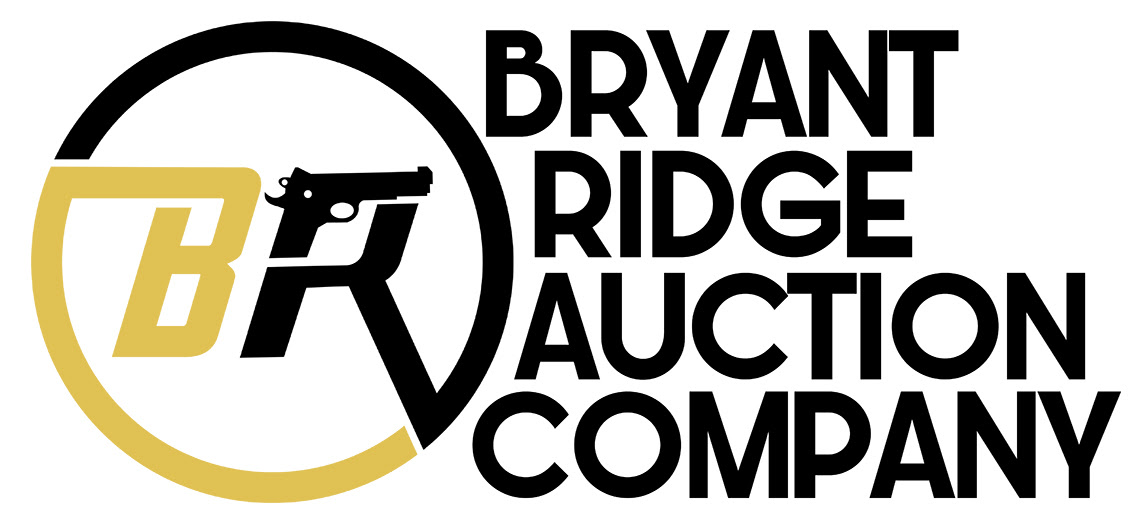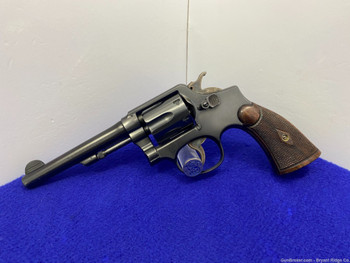Description

Item Description
Bryant Ridge Auction Company is pleased to present this double-action revolver today for a penny start auction; this is the Smith & Wesson .38 Military & Police Model of 1902!
SPECIFICATIONS:
Manufacturer: Smith & Wesson
Model: .38 Military & Police Model of 1902!
Serial: 30100
Date of Manufacture: 1902
Caliber: .38 S&W Special
Finish: Blue
Barrel Length: 6.5"
Optics/Sights: Round blade front with notched rear
Stock/Grips: Synthetic with texturing and S&W logos
Action: Double-Action Revolver
Markings: Standard / " .38 S&W Special and U.S. Service CTG" on the left side of the barrel
Bryant Ridge's Analysis:
The K-frame revolver was introduced in 1899 as the .38 Military Model 1899. Curiously, it was cataloged as one gun chambered in three different cartridges: the .38 S&W Special, the .38 US Service Cartridge, and the .32 Winchester. The two .38 cartridges are the same, as far as this revolver is concerned. The .32 Winchester is a different cartridge; perhaps because of this difference, it was serial-numbered in its own series. This separation continued until the end of its production in about 1940.
The .38 Military Model 1899 was offered in three different barrel lengths: 4", 5", and 6 1/2", and in two different finishes: blue and nickel. The butt configuration was round - as were all the handguns offered by the factory in 1899, except for the single-shot. (Under the extension stocks, the factory felt that this was a square-butt offering, even though the frame was round-butt. ) Adjustable target sights were optional. A unique feature of this hand ejector was the lack of a locking point for the end of the extractor rod.
The .38 Military Model 1902 added the extractor lug under the barrel and redesigned the extractor rod itself to house a full-length center locking pin that engaged the lug under the barrel. Otherwise, the gun was identical to the model of 1899. This front-locking point was very important to the factory, as it allowed them to distinguish themselves from the other competitors. They secured a patent for this locking arrangement, and that effectively forced Colt to not use a front locking point. In the catalogs and other advertising, Smith & Wesson got a lot of mileage from this feature. The 1902 was offered in the same three calibers, the same three barrel lengths, the same two finishes, and the optional target sights. And, it was offered in a round butt frame only, as were all the other catalog offerings.
In October 1903, the factory made an engineering change that increased the diameter of the threaded portion of the barrel and simultaneously increased the diameter of the receiver area of the frame. The factory elected to keep the taper of the barrel the same, so the increased thread diameter brings about the addition of a shoulder on the barrel at the point where the barrel meets the frame. This has an unintended effect on the patent-date roll markings on the top of the barrel; on the 4" barrels, there is no longer enough flat area in which to place the roll markings, so they are moved to the right side of the barrel. On this short barrel, these markings take three lines and will remain on the side of the barrel for another 10 or more years.
At this point, the Collectors (circa 1935) want to distinguish this engineering change, and so for Collector purposes, this gun becomes known as the .38 Military Model 1902 1st Change. This change is not noted (by the factory) in the catalogs, but it serves a purpose for Collectors in distinguishing between these two barrel configurations. Again, nothing else changes - but not for long.
It is worth noting that the above-referenced Collectors are, in 1935, the McHenry & Roper book. However, their ideas about the changes are actually coming from the factory's internal designations. The factory, internally, is keeping track of the engineering changes because some of the later-made parts are not compatible with earlier frames. Roper ( a factory employee) and McHenry provide and document the methodology that we use today, namely the notions of 1st Change, 2nd Change, etc. This contrasts with the factory's preference for keeping engineering changes out of the catalogs, thereby providing stability for their identified models.
Return Policy:
We gladly offer a 3 day unfired inspection policy from the time that the firearm is delivered to your FFL. Refunds are available for all qualifying orders.
Model: .38 Military & Police Model of 1902!
Serial: 30100
Date of Manufacture: 1902
Caliber: .38 S&W Special
Finish: Blue
Barrel Length: 6.5"
Optics/Sights: Round blade front with notched rear
Stock/Grips: Synthetic with texturing and S&W logos
Action: Double-Action Revolver
Markings: Standard / " .38 S&W Special and U.S. Service CTG" on the left side of the barrel
Bryant Ridge's Analysis:
The K-frame revolver was introduced in 1899 as the .38 Military Model 1899. Curiously, it was cataloged as one gun chambered in three different cartridges: the .38 S&W Special, the .38 US Service Cartridge, and the .32 Winchester. The two .38 cartridges are the same, as far as this revolver is concerned. The .32 Winchester is a different cartridge; perhaps because of this difference, it was serial-numbered in its own series. This separation continued until the end of its production in about 1940.
The .38 Military Model 1899 was offered in three different barrel lengths: 4", 5", and 6 1/2", and in two different finishes: blue and nickel. The butt configuration was round - as were all the handguns offered by the factory in 1899, except for the single-shot. (Under the extension stocks, the factory felt that this was a square-butt offering, even though the frame was round-butt. ) Adjustable target sights were optional. A unique feature of this hand ejector was the lack of a locking point for the end of the extractor rod.
The .38 Military Model 1902 added the extractor lug under the barrel and redesigned the extractor rod itself to house a full-length center locking pin that engaged the lug under the barrel. Otherwise, the gun was identical to the model of 1899. This front-locking point was very important to the factory, as it allowed them to distinguish themselves from the other competitors. They secured a patent for this locking arrangement, and that effectively forced Colt to not use a front locking point. In the catalogs and other advertising, Smith & Wesson got a lot of mileage from this feature. The 1902 was offered in the same three calibers, the same three barrel lengths, the same two finishes, and the optional target sights. And, it was offered in a round butt frame only, as were all the other catalog offerings.
In October 1903, the factory made an engineering change that increased the diameter of the threaded portion of the barrel and simultaneously increased the diameter of the receiver area of the frame. The factory elected to keep the taper of the barrel the same, so the increased thread diameter brings about the addition of a shoulder on the barrel at the point where the barrel meets the frame. This has an unintended effect on the patent-date roll markings on the top of the barrel; on the 4" barrels, there is no longer enough flat area in which to place the roll markings, so they are moved to the right side of the barrel. On this short barrel, these markings take three lines and will remain on the side of the barrel for another 10 or more years.
At this point, the Collectors (circa 1935) want to distinguish this engineering change, and so for Collector purposes, this gun becomes known as the .38 Military Model 1902 1st Change. This change is not noted (by the factory) in the catalogs, but it serves a purpose for Collectors in distinguishing between these two barrel configurations. Again, nothing else changes - but not for long.
It is worth noting that the above-referenced Collectors are, in 1935, the McHenry & Roper book. However, their ideas about the changes are actually coming from the factory's internal designations. The factory, internally, is keeping track of the engineering changes because some of the later-made parts are not compatible with earlier frames. Roper ( a factory employee) and McHenry provide and document the methodology that we use today, namely the notions of 1st Change, 2nd Change, etc. This contrasts with the factory's preference for keeping engineering changes out of the catalogs, thereby providing stability for their identified models.
Return Policy:
We gladly offer a 3 day unfired inspection policy from the time that the firearm is delivered to your FFL. Refunds are available for all qualifying orders.
Shipping Details
Handgun Standard Shipping with Insurance $50.00
Long Gun Standard Shipping with Insurance $70.00
Any orders placed with magazines that are not compliant with your state, county, or city regulations will not ship with your order.
















